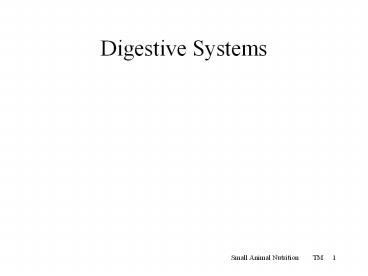Digestive Systems - PowerPoint PPT Presentation
1 / 12
Title:
Digestive Systems
Description:
Title: The Ruminant Digestive System Author: Department of Education Last modified by: Raegan Harris Created Date: 8/30/2001 1:27:00 PM Document presentation format – PowerPoint PPT presentation
Number of Views:173
Avg rating:3.0/5.0
Title: Digestive Systems
1
Digestive Systems
2
Agriculture, Food, and Natural Resource Standards
Addressed
- AS.03.01. Analyze the nutritional needs of
animals. - AS.03.01.01.a. Identify and summarize essential
nutrients required for animal health and analyze
each nutrients role in growth and performance. - AS.03.02 Analyze feed rations and assess if they
meet the nutritional needs of animals. - AS.03.02.01.c. Select appropriate feedstuffs for
animals based on a variety of factors (e.g.,
economics, digestive system and nutritional
needs, etc.)
3
The Ruminant Digestive System
Small intestine
Rectum
Rumen
Cecum
Esophagus
Reticulum
Omasum
Colon
Abomasum
4
The Non-Ruminant Digestive System
Rectum
Colon
Stomach
Esophagus
Small intestine
Cecum
5
The Cecal Fermenter Digestive System
Rectum
Small intestine
Esophagus
Stomach
Cecum
Colon
6
The Digestive Process
- Mechanical digestion begins in the mouth where
food is chewed and broken down into smaller
pieces
Peristalsis a muscular contraction that causes
food to move through the digestive tract
- Chemical digestion enzymes and acids reduce
food particle size and change particles into
forms that can be used by the animal
Absorption nutrients are absorbed into the
blood stream through the intestinal villi
Metabolism nutrients are removed from the
bloodstream and used by the body organs for
things like bone and hair growth, maintaining
body temperature, etc.
7
Major Nutrients Functions
- Protein- Development and repair of body organs
and tissues. Production of wool, milk, eggs.
Fetal development. Production of hormones and
enzymes. Antibody development. Transmission of
DNA. - Carbohydrates- Support bodily functions such as
breathing, digestion, and exercise. Help
maintain body temperature. Store fat. - Lipids- Enhance palatability and caloric value of
feed. Provide energy. Provide fatty acids for
healthy skin and coat. Aid in absorption of fat
soluble vitamins. Help maintain body
temperature. Provide essential materials for
hormone secretion.
8
Major Nutrients Functions cont.
- Water- Support biochemical reactions
(respiration, digestion, conversion of food to
absorbable components). Transport of nutrients.
Help maintain body temperature. Helps give the
body its form. Carries waste form the body. - Vitamins- Regulate digestion, absorption,
metabolism, gland activity, and cell formation.
Necessary for normal vision. Fights diseases.
Develop a healthy nervous system. - Minerals- Furnish structural material for teeth
and bones. Aid in building body tissue,
digestion, muscle activity, and transmission of
messages through the nervous system. Part of
hormones.
9
Marketing Concepts
- Nutritional value markets food based on
specific nutritional content of the food. - All purpose based on the concept that one food
is adequate for all stages of the pets life. - Price uses low price concept or more for
your money. Price can be very misleading. - Palatability markets based on how the food
tastes to the pet
10
Cost per Feeding Analysis
- Determines cost per day and per year
- Compares pet foods for economical value
(which one gives you more for your money) - The most economical pet food may be the more
expensive one!
11
What is Dry Matter
- Dry matter nutrient content of a food after all
water has been removed - When comparing a wet food to a dry food is
necessary to first determine the dry matter
content. This gives a more accurate nutritional
comparison. - Dry matter 100 - moisture
- I.e. A canned food with 70 moisture has 30 dry
matter - 100 - 70 30 dry matter
12
Calculating MER Maintenance Energy Requirements
- MER Maintenance Energy Requirements
- MER is the amount of energy needed by an animal
to keep it in good health. It varies with age,
activity level, production, reproduction, and
environmental conditions. - MER is measured in kilocalories per day
(Kcal/day)































